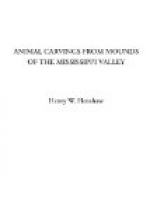There is no reason for believing that the people who wrought stone and clay into perfect effigies of animals have not left us sculptures of their own faces in the images exhumed from the mounds;” and again, “The perfection of the animal representations furnish us the assurance that their sculptures of the human face were equally true to nature.
Squier and Davis also appear to have had no doubt whatever of the capabilities of the Mound-Builders in the direction of human portraiture. They are not only able to discern in the sculptured heads niceties of expression sufficient for the discrimination of the sexes, but, as well, to enable them to point out such as are undoubtedly ancient and the work of the Mound-Builders, and those of a more recent origin, the product of the present Indians. Their main criterion of origin is, apparently, that all of fine execution and finish were the work of the Mound sculptors, and those roughly done and “immeasurably inferior to the relics of the mounds,” to use their own words, were the handicraft of the tribes found in the country by the whites. Conclusions so derived, it may strike some, are open to criticism, however well suited they may be to meet the necessities of preconceived theories.
After discussing in detail the methods of arranging the hair, the paint lines, and tattooing, the features of the human carvings, Squier and Davis arrive at the conclusion that the “physiological characteristics of these heads do not differ essentially from those of the great American family.”
Of later writers some agree with Squier and Davis in believing the type illustrated by these heads to be Indian; others agree rather with Wilson, who dissents from the view expressed by Squier and Davis, and, in conformity with the predilections visible throughout his work, is of the opinion that the Mound-Builders were of a distinct type from the North American Indian, and that “the majority of sculptured human heads hitherto recovered from their ancient depositories do not reproduce the Indian features.” (Wilson’s Prehistoric Man, vol. 1, p. 469.) Again, Wilson says that the diversity of type found among the human sculptures “proves that the Mound-Builders were familiar with the American Indian type, but nothing more.”—Ibid., p. 469.
The varying type of physiognomy represented by these heads would better indicate that their resemblances are the result of accident rather than of intention. For the same reason that the sculptured animals of the same species display great differences of form and expression, according to the varying skill of the sculptors or the unexacting demands made by a rude condition of art, so the diversified character of the human faces is to be ascribed, not to the successful perpetuation in stone by a master hand of individual features, but simply to a want of skill on the part of the sculptor. The evidence afforded by the animal sculptures all tends to the conclusion that




